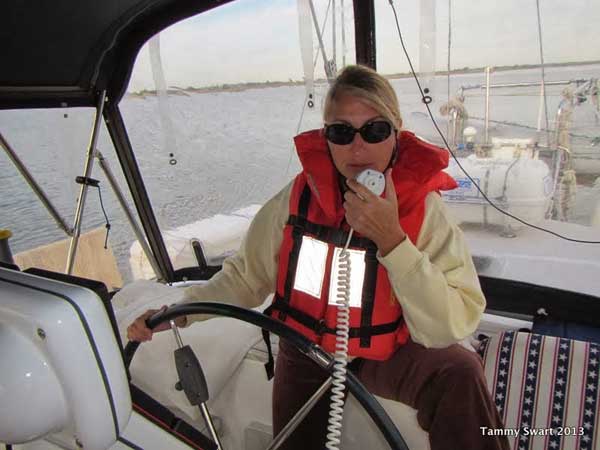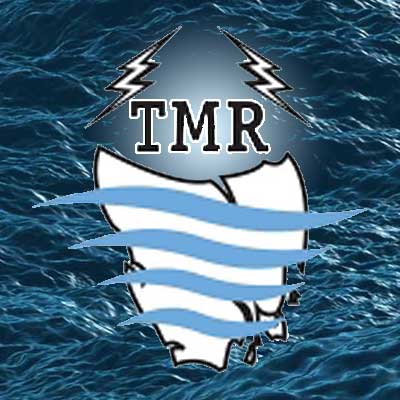
Basic Radio Procedure
Correct radio procedure can save lives.
Poor radio procedure not only annoys other people but can obstruct search and rescue operations in extreme cases. Good radio procedure may save your life and vessel, or someone else's life and vessel, some day.
Who is responsible?
As master of your vessel you are responsible for the use of your radio. If a guest aboard transmits a hoax Mayday for example, then it is you who will be held responsible, and possibly charged with an offence.
Distress/Calling Channels and Frequencies
Special channels or frequencies are allocated for distress (emergencies) or calling (making initial contact).
On VHF, channel 16 is the distress/calling channel.
On HF, frequencies 4125, 6215 and 8291 kHz are the distress/calling frequencies. (There are others in the higher
bands, right up to 20MHz, but these are the only ones that Tas Maritime Radio monitors).
Because these are used for emergencies as well as calling it is important to keep your use of these channels/frequencies as short as possible. Do not conduct conversations of any length on them.
Tas Maritime Radio announces skeds on these channels and frequencies and then directs you to a working channel.
Working Channels/Frequencies
The VHF working channels are channels 72, 73 and 77.
The HF working frequencies are 4146, 6227 and 8294 kHz.
These are the channels and frequencies you can use to pass your messages or converse on once you have made contact using the calling channel/frequency. Remember though that your communication is not private – any vessel tuned to your working channel or frequency will hear what is said.
Making a Radio Call
The procedures for HF and VHF communications are essentially the same. The procedures here are tailored to TMR members who have an "RG" number for their vessel. Use your RG number for communicating with TMR. If you are communicating with another coast station (such as Coast Radio Sydney) you should use your vessel name and ACMA callsign. This website will use the "RG" number for routine communication (because we already have the other information in our database). In an emergency use the vessel's name as well.
Step 1: Make sure the calling channel/frequency is clear
Listen for a moment before transmitting to make sure that you don’t cut across someone else’s call. This is especially important if there’s an ongoing distress call. If there is traffic … wait. If there's emergency traffic, stay off this channel/frequency unless you can render assistance.
Step 2: Initiate your call
| • The vessel name or callsign of the station you are calling, spoken twice. | ||
| • The words "this is"; | ||
| • Your vessel name or callsign, spoken twice; | ||
| • The channel or frequency you are using; | ||
| • If you are calling another vessel, suggest a working channel. A coast station will direct you to their preferred working channel; | ||
| • the word "over". |
Here is an example of a radio call to Tas Maritime Radio,
Tas Maritime would then direct you to change to a working channel.
Step 3: Make your report
The exchange then continues on a working channel. Each party should use the word “over” to invite the other to speak.
When providing a position report to Tas Maritime Radio, please include the following:
| • Your position relative to a well-known landmark, such as: | |||
| - Abeam Cape Raoul; | |||
| - 2 nautical miles SE of Flinders Island; | |||
| - Anchored in Recherche Bay overnight. | |||
| • If you are offshore – your latitude & longitude; | |||
| • Your intention, for example: | |||
| - En route for Kettering; | |||
| - Will head for St. Helens tomorrow morning ETA midday. | |||
If you provide the course that you are steering, make sure you tell us whether it is True or Magnetic. (Click here to find out more about true and magnetic bearings.)
Here are two examples of a position report: the first is a vessel within sight of land, the second is a vessel making an ocean passage, giving his position in latitude and longitude.
Step 4: Signing off
When concluding their conversation, conclude with: This is RG888 – clear or This is RG888 – out.
Then set your radio back to channel 16.
Repeating Calls
If the called station does not respond to your call, wait 2 minutes before trying again. If there’s still no response, wait another 3 minutes before trying again. If there’s still no response consider calling another station to find whether the station you are calling is in range.
Do not keep calling and calling without waiting the required time (this does not apply to distress calls).
This is an example of a complete radio exchange between a vessel and Tas Maritime Radio - the vessel is calling in to file a position report.
